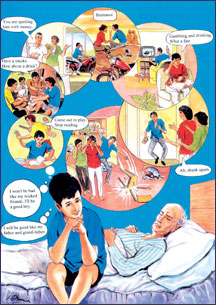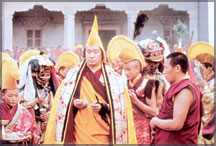|
DAILY NEWS ONLINE |
|
|
|
OTHER EDITIONS |
|
|
|
|
|
|
|
|
|
OTHER LINKS |
|
|
|
|
|
|
  |
|
|
|
|
It is belted by on the northern side by the snow capped mountains, ranging from 1829 m to 6400 m in height and by the plains of Brahmaputra valley in the south. Green forest cover spreads over sixty per cent of the land area. The earliest recorded history of Arunachal Pradesh is datable to the 16th century when Ahom rulers of Assam annexed this region to their kingdom. There are about 26 main tribes in the State, further divided into numerous clans and sub-tribes.
Incidentally, India with its one billion plus population has around 448 dialects. Races and tribes of these dialects live in either small and large villages and call them their 'homelands' and the majority do not rule them for such claims.
The tribes Monpas and Sherdukpens two of the 26 main tribes in Himachal Pradesh's Kameng and Tawang districts, came into contact with the Tibetans in the north many centuries ago and adopted Lamaistic Buddhism, while the Khamtis in Lohit district, who migrated quite early from Thailand, adopted Mahayana Buddhism.
However, a large number of people practise their own ancient beliefs and follow indigenous animistic religious beliefs and practices. But these practices are based on respect to man, animal and nature, and could be equated to the unadulterated concepts and practices of Buddhism.
Their life-long commitment is 'non-violence' to the ecosystem, fauna and flora, and mankind and are more Buddhistic than the self-proclaimed Buddhists with no linkage with Buddhist concepts of loving kindness, compassion, blissful joy, and equanimity.
The economy of the entire region is agro-pastoral. The three animals, yak, sheep and horse are the mainstay of the Monpa Buddhists' lifestyle. They provide them with raw materials for their clothing (yak and sheep) and horses beasts of burden and transport in these steep hilly regions.
Sheep rearing is very common. The yak and horses are allowed to roam untended. Interestingly Monpas are fond of using products of milk, whereas drinking milk is abhorred by other tribes as they feel that milk is meant only for the calves and not humans. Yak's milk is churned into butter and cheese.
The Monpas are enamoured with drinking tea, mixed with salt and butter and with no sugar. All these ingredients are churned in a cylindrical churner invented locally. Their drinking cups are just tumblers made of bamboo.
Times of recent Monpa Buddhists have adopted modern agricultural practices giving up the traditional farming or shifting cultivation practised in other parts of Arunachal Pradesh. They do not use insect-killing chemical fertilizers and other chemical products but use organic manure. The principal crops grown by Monpas are maize, millet, barley, chillies and a little wheat and oats. They are self-sufficient in food and there is some trade in products such as chillies, garlic and onions.
The Monpa women are adept at weaving and making their own garments and making colourful carpets with exquisite designs, with motifs of a Tibetan and Bhutan influence painting is relatively non-existent in Arunachal Pradesh except in West Kamang and Twang due to Buddhist influence. The people of these two districts paint the walls of their Buddhist shrines with brightly coloured murals depicting scenes of Buddha's life and events and other Buddhist folklore.
They excel in making decorative wooden bowls, cups, masks, Tankhas (painted cloth wall hanging) and wooden sculptures. One of their most highly respected creation is an intricately carved wooden chest with floral and dragon murals. The latter a migrant motif from mainland China.
Another unique facet in the Monpa's lifestyle is the ingenious water wheels which can be seen all over the place near small streams. They are housed in ornamented small buildings. Water power is thus harnessed for grinding grains as well as for driving prayer wheels, a concentration to venerate the Buddha through chanting being mindful of the turns of the huge prayer wheel.
The Monpas are deeply committed Buddhists and belong to the Yellow Sect of Mahayana Buddhism. Thus they are quite distinct from other tribes practising animism and other little known concepts, rites and rituals. The entire Monpa region is dotted with Gompas (Buddhist shrines).
Prayer wheels turning Monpa Buddhists are a common sight at Buddha Gaya (India) circumbulating around the sacred Bodhi and Vajrasana (seat of Enlightenment of the Buddha) for hours together in meditative whispering prayers.
On every roof-top of houses and other places flutter red, green, white, yellow and blue (colours of the Buddha's halo) inscribed with prayer. These colours represent the five elements in nature (panchabhutadhatus). The Monpas belief is that the prayers on the flags are carried by the winds in all directions, bringing peace, and prosperity to the entire humanity.
The Twang Gompa is the epicentre of religious and cultural life of the Monpas. It is the biggest Buddhist monastery in India built like a fort on the cross-section of huge mountain at an altitude of ten thousand feet.
The old wooden one was recently renovated and a brick work is now in situ. The building is totally in the traditional Buddhist architectural tradition, with the interior ornamented with paintings, murals, carvings and sculptures. The Gompa has a huge image of the Buddha almost 30 feet in height. The monastery holds the famous Torgya festival annually during May Purnima (Vaiskha or Vesak) called in Monpa language Losar. This festival is deemed to drive away evil spirits to enable people to live in peace and harmony during the ensuing year.
In the courtyard of this Buddhist temple a variety of ritual dances are performed by the people wearing beautifully designed costumes and masks. No animals are used and the people in groups form them into four-footed animals, in these festivals and processions as ill-treating of animals are anathema to their creed and ethos. Each dance is associated with some myth or legend.
Dance like Pha Cham is performed by the common people. Losker Chungtye Cham, where the dancers dress up as cows, tigers, sheep, monkeys etc. is performed by the Monpa Mahayana monks themselves. Certain dances could be performed at the Gompa only (monastery) while others can be performed during any festive season. The most famous amongst the latter is the lion and peacock dance.
The climate of Arunachal Pradesh varies with the altitude. The southern part of the state has hot and humid sub-tropical climate; the central region is cooler while alpine climate is prevalent in the higher altitudes.
The rainfall is uneven and continues throughout the year, the wettest segment of the year is from May to September. The people of thee regions, Himachal Pradesh, Tibet, Bhutan, Sikkim in the foot hills of Himalayan ranges are of Mongolian extraction, as was the case with Nepal group. The 6th Dalai Lama was from Himachal Pradesh and the present sanctuary of the Dalai Lama, who fled Tibet after Communist China took over Tibet. Dharmasala too is in Himachal Pradesh.
|
|



